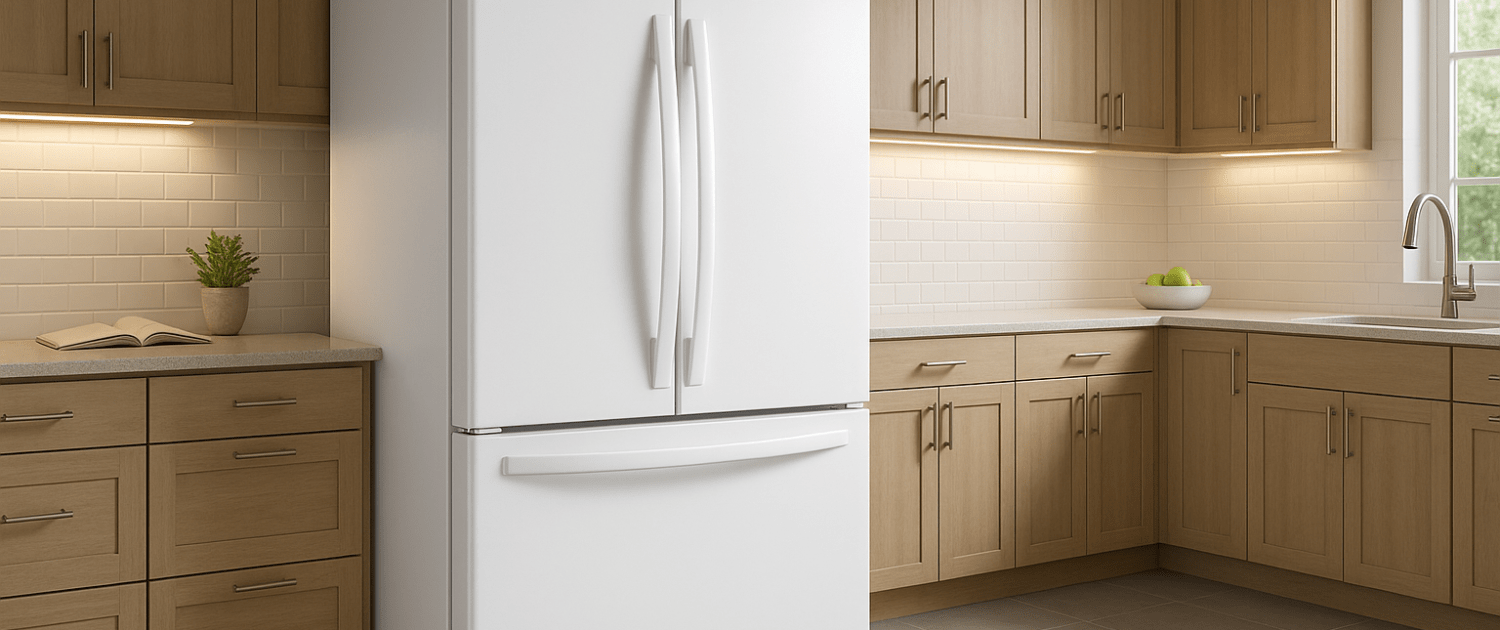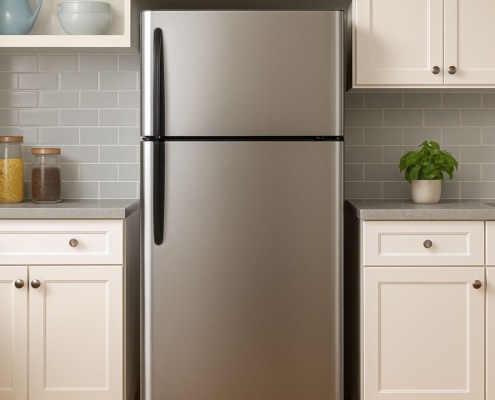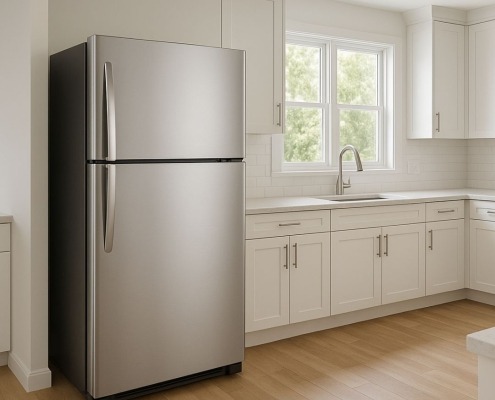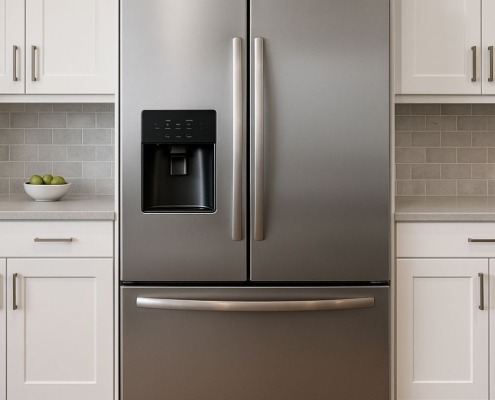How to Choose the Right Size Refrigerator for Your Home
Steven E / Tuesday May 6, 2025
Choosing the right refrigerator size to fit your needs and available space can be a daunting task. With a variety of options on the market, each boasting its own set of features and dimensions, finding the perfect refrigerator can quickly become overwhelming.
This guide aims to demystify the world of refrigerator sizes, helping you make an informed decision that not only complements your lifestyle but also seamlessly integrates into your kitchen layout. By the end of this article, you’ll be equipped with the knowledge needed to confidently select the perfect refrigerator size that suits your specific requirements.
Whether you’re embarking on a kitchen remodel or simply in need of a refrigerator upgrade, let’s dive into the world of refrigerator sizes and find the ideal fit for your home and lifestyle.
If you need any replacement parts for your appliance, you can enter your model number at AppliancePartsPros.com to order them. Most orders arrive in just two business days, and we have thousands of free guides to show you how to install your new parts.
The information in this article may not apply to your specific appliance model. We recommend consulting your manufacturer’s documentation or contact us with any questions.
Standard refrigerator sizes
Refrigerators come in a range of dimensions to suit different needs and kitchen configurations. In this section, we will delve into the details of these standard refrigerator sizes, helping you grasp the options available and their respective advantages and disadvantages.
Full-size refrigerators
These are the most common and versatile refrigerators, typically ranging from 28 to 36 inches in width, 65 to 70 inches in height, and 29 to 35 inches in depth. They offer ample storage space for fresh and frozen items and come in various configurations, including top-freezer, bottom-freezer, and side-by-side models.
- Advantages: Ample storage space, various configurations, suitable for large families.
- Disadvantages: May not fit well in smaller kitchens, higher energy consumption.
Counter-depth refrigerators
Counter-depth refrigerators are designed to align with the depth of standard kitchen countertops, usually around 24 to 30 inches deep. While they may sacrifice some interior storage space compared to full-size models, they offer a streamlined and built-in appearance.
- Advantages: Built-in appearance, space-efficient depth, suitable for modern kitchens.
- Disadvantages: Reduced interior capacity, potentially higher cost.
Apartment-sized refrigerators
These refrigerators are designed with smaller kitchens in mind, making them ideal for apartments and condos. They typically range from 23 to 28 inches in width, 60 to 69 inches in height, and 26 to 30 inches in depth. They offer a compact footprint while still providing essential refrigeration functions.
- Advantages: Compact footprint, ideal for small kitchens, energy-efficient.
- Disadvantages: Limited storage space, fewer features in some models.
Compact or mini-fridges
Compact refrigerators, often referred to as mini-fridges, are the smallest refrigerator option. They are perfect for dorm rooms, offices, and areas where space is limited. They usually measure around 15 to 24 inches in width, 17 to 34 inches in height, and 15 to 24 inches in depth.
- Advantages: Extremely space-efficient, portable, versatile placement options.
- Disadvantages: Minimal storage capacity, not suitable for large households.
Measuring your space
In this section, we’ll walk you through the essential steps for measuring your kitchen space to ensure your chosen refrigerator fits perfectly.
- Measure from the floor to the underside of your upper cabinets or any obstacles above the refrigerator’s intended location.
- Ensure there is enough clearance for the refrigerator’s height, including hinge clearance if it’s a top-freezer model.
- Measure the width of the space where the refrigerator will be placed. Pay attention to any recesses or alcoves.
- Consider the door swing space and leave enough clearance for the refrigerator’s doors to open fully.
- Measure from the wall to the front edge of the counter or any obstacles that may affect the depth of the refrigerator.
- If you’re considering a counter-depth refrigerator, ensure the depth matches the depth of your countertops.
- Check for nearby electrical outlets, water lines, and ventilation requirements, as these can impact refrigerator placement.
- Measure the pathway from your front door to the kitchen to ensure the refrigerator can be delivered without obstruction.
- Measure the width of all doorways and hallways the refrigerator will pass through during delivery.
- Consider the angles and any tight corners that might require extra clearance.
- If your home has stairs or an elevator, measure their dimensions to ensure the refrigerator can be transported safely.
Choosing the right size
Selecting the right refrigerator size is an important decision that directly impacts your kitchen’s functionality, aesthetics, and your daily life. In this section, we will explore the factors to consider when determining the ideal refrigerator size for your home.
Small kitchens
- For small kitchens, consider counter-depth or apartment-sized refrigerators to maximize space.
- Opt for models with clever storage solutions, like adjustable shelving and door storage, to make the most of limited space.
Large families
- Full-size refrigerators with ample storage space are ideal for large families. Look for side-by-side or French door models with spacious interiors.
- Consider additional features such as ice and water dispensers for added convenience.
Apartment living
- Apartment-sized or compact refrigerators are designed with limited space in mind. They fit well in apartment kitchens and smaller living spaces.
- Prioritize energy efficiency and space optimization in these scenarios.
Secondary refrigerator needs
- If you need a secondary refrigerator for overflow or specific items, such as beverages or freezer items, consider a compact or mini-fridge.
- These smaller units can be placed in garages, basements, or other convenient locations.
Custom and built-in refrigerators
While standard refrigerator sizes are the most common choice, custom and built-in refrigerators offer unique advantages for those seeking a seamless integration into their kitchen design.
Custom refrigerators are designed to be built into your kitchen cabinetry, allowing for a truly integrated and cohesive look. They often feature panels that match your kitchen’s cabinetry, effectively concealing the appliance for a streamlined appearance. Custom models come in various sizes, from full-size to under-counter units, catering to different kitchen configurations.
Built-in refrigerators are similar to custom models but may not be entirely concealed. They are designed to fit seamlessly within your kitchen layout. They are available in various configurations, including French door, side-by-side, and bottom-freezer designs.
Benefits
- Custom and built-in refrigerators blend seamlessly with your kitchen’s aesthetic, providing a high-end and cohesive appearance.
- They are designed to maximize storage space within your kitchen, often with clever storage solutions like deep shelves and drawers.
- Many custom and built-in models offer advanced features such as precise temperature control, air filtration, and humidity control.
- These refrigerators often use premium materials, both inside and out, ensuring durability and longevity.
Challenges
- Custom and built-in refrigerators tend to be more expensive than standard models, both in terms of the appliance itself and installation costs.
- Installation can be complex and may require professional help to ensure a proper fit and function.
- Once installed, these refrigerators are less flexible in terms of relocation, so careful planning is essential.
- Custom and built-in options may have size constraints based on your kitchen’s cabinetry and layout, which could limit your choices.
Custom and built-in refrigerators offer a high level of customization and aesthetic appeal. However, they come with added costs and complexities, so weigh these factors against the benefits when making your decision.
Additional information
Thanks for reading! If you need replacement parts for any of your appliances, check out AppliancePartsPros.com, where you can enter your model number to find exactly what you’re looking for. Most orders arrive in two business days, and we have thousands of free resources to show you how to install your new parts.
You can also reach our award-winning customer service team at 1-877-477-7278, chat with a pro on our website and watch thousands of free video tutorials on our YouTube channel.
With nearly a decade of experience in providing top-notch customer service regarding appliance parts and repair, Steven enjoys sharing practical advice, troubleshooting tips, and interesting information to help readers stay informed.





